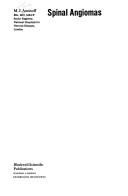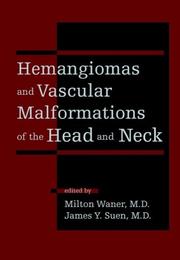| Listing 1 - 10 of 20 | << page >> |
Sort by
|
Book
Abstract | Keywords | Export | Availability | Bookmark
 Loading...
Loading...Choose an application
- Reference Manager
- EndNote
- RefWorks (Direct export to RefWorks)
Book
Year: 2011 Publisher: Bruxelles: UCL,
Abstract | Keywords | Export | Availability | Bookmark
 Loading...
Loading...Choose an application
- Reference Manager
- EndNote
- RefWorks (Direct export to RefWorks)
Hemangioma --- Infant --- Child --- DNA

ISBN: 0632002379 Year: 1976 Publisher: Oxford Blackwell
Abstract | Keywords | Export | Availability | Bookmark
 Loading...
Loading...Choose an application
- Reference Manager
- EndNote
- RefWorks (Direct export to RefWorks)
Spinal angiomas --- Hemangioma --- Hemangioma --- Spinal Cord Neoplasms --- therapy
Book
Year: 2016 Publisher: Bruxelles: UCL. Faculté de médecine et de médecine dentaire,
Abstract | Keywords | Export | Availability | Bookmark
 Loading...
Loading...Choose an application
- Reference Manager
- EndNote
- RefWorks (Direct export to RefWorks)
The topic of this thesis in medicine is based on the management of choroidal hemangiomas treated with photodynamic therapy (PDT) and is supervised by Professor P. De Potter, Head of the Ophthalmological Department and the Ocular Oncology Unit at the St. Luc university hospital. The ocular lesion we study is a benign vascular tumor which arises within the choroidal layer, the eyeball vascular tunic. Choroidal hemangioma may present itself with two patterns : a circumscribed form and a diffuse form. However, our study is focused on the circumscribed form. The first section of our work will be articulated into three parts firstly, we will aim at analyzing various epidemiological, histological and physiological data. Secondly, we will address symptoms and clinical signs that lead ophthalmologists to establish this diagnosis. We will then provide a detailed assessment that will allow us to ascertain the CCH diagnosis, since the differential diagnosis can be complex if a direct or indirect ophthalmoscopy is made. We will eventually describe PDT, the therapeutic method used in our study. CCH are not necessarily symptomatic, but we currently estimate the prevalence rate of symptomatic choroidal hemangiomas at about 1/2500000 a year. But their precise incidence is unknown as many CCH are asymptomatic and never clinically diagnosed. CHH is regarded as a benign tumor. Since it can be asymptomatic, this benign uveal tumor can be discovered during a routine eye examination. The exudative activity of the hemangioma with accumulation of sub retinal fluid will trigger visual symptoms such as blurred vision, metamorphosis, and/ or visual scotomas generally appearing during the fourth decade of life. Although the CHH usually show' Le sujet de ce mémoire en médecine est basé sur les hémangiomes choroïdiens traités par la photothérapie dynamique (PTD) et ce travail est supervisé par le Professeur P. De Potter, chef du service d'ophtalmologie de l'hôpital universitaire Saint-Luc. La lésion ophtahnique que nous étudions est une tumeur vasculaire se développant au sein de la choroïde, la tunique vasculaire du globe oculaire. Cette atteinte oculaire peut se subdiviser en deux grandes catégories : les hémangiomes circonscrits et les diffus. I'étude concerne la forme circonscrite. Dans un premier temps, l'ouvrage présente des données épidémiologiques, les différentes présentations histologiques et des explications physiopathologiques. Ensuite, nous discutons des symptômes et des signes cliniques qui amènent l'ophtahnologue à envisager ce diagnostic. Après, nous décrivons le bilan nécessaire pour poser définitivement le diagnostic d'HCC car le diagnostic différentiel peut être complexe si on ne s'octroie qu'une ophtalmoscopie directe ou inclirecte. Finalement, nous parlons de la PTD, la méthode thérapeutique utilisée dans notre étude. Les HCC ne sont pas obligatoirement symptomatiques mais on évalue actuellement la prévalence des hémangiomes choroïdiens symptomatiques à =1/ 2 500 000 / an. L'HCC peut donner une sévère altération de l'acuité visuelle au long terme. Néanmoins, on considère la lésion choroïdienne circonscrite comme une tumeur bénigne. Cette tumeur uvéale bénigne peut être découverte fortuitement puisque celle-ci peut être asymptomatique. Elle est très souvent cliagnostiquée lorsqu'elle présente une activité exsudative tarclive, habituellement pendant la quatrième décade. Les HCC peuvent se présenter de deux manières distinctes. La première situation est la découverte fortuite. C'est à l'ophtalmoscopie que le praticien observe un fond d'œil anormal. Soit, a contrario, le parient est symptomatique ce qui l'amène à consulter. Dans cette dernière situation, nous sommes confrontés soit, à un patient jeune (p.ex. il se présente avec une hypermétropie franche de cliagnostic récent) soit, à un patient d'une quarantaine d'années avec clivers symptôtnes possibles. Un large diagnostic différentiel existe et afin d'être certain du diagnostic, des examens complémentaires seront nécessaires. A notre disposition, nous retrouvons : l'échographie, l'IVFA, l'ICG, l'OCT, le CT, l'IRM, le phosphore radioactif, l'autofluorescence au fundus et la biopsie. Pour la prise en charge de ces tumeurs vasculaires bénignes, la photothérapie dynamique est proposée. Dans la PTD, on utilise une lumière monochromatique et un agent qui absorbe cette lumière, c'est-à-clire, un photosensibilisant. La vertéporfine (Visudyne®) est un photosensibilisant injecté en intraveineux qui, combiné à un environnement riche en oxygène et soumis à la lumière, donne une réaction photochimique. La fibrose du tissu vasculaire, qui fait suite à cette photothrombose, conduit à la régression tumorale (démontrable par angiographie). Dans le cadre des HCC, le but n'est pas d'éliminer totalement la tumeur mais plutôt d'annihiler sa propension exsudative. La PTD peut s'administrer selon différents protocoles qui sont fonction du temps d'injection, du temps d'intervalle entre la perfusion du photosensibilisant et l'exposition à la lumière, la taille du spot et l'énergie induite. Une courte synthèse de la littérature est réalisée pour cette thérapie exclusive afin de montrer ses avantages, ses éventuelles cotnplications et sa supériorité par rapport aux autres thérapies actuellement disponibles. Dans un second temps, nous rentrons au cœur du sujet en expliquant précisément le matériel utilisé ainsi que le protocole entrepris durant cette étude interventionnelle et prospective. Les résultats de notre étude viendront par la suite appuyer notre hypothèse clinique de départ : la PTD est une thérapie d'avenir dans le management des HCC par sa relative innocuité et sa grande efficacité. Effectivement, parni les 29 patients présents dans notre étude, seul un individu a souffert d'une complication visuelle et l'AV s'est amoindrie dans un seul cas. Une majorité nette de patients a bénéficié d'une augmentation ou d'une stabilisation de son AV sans aucune complication associée. Le chapitre final tirera des conclusions quant à fiabilité de notre étude, aux résultats obtenus et à l'impact potentiel au sein de la littérature scientifique dans le domaine de l'oncologie oculaire. Depuis la première publication au sujet des HCC, les experts se plaignent d'un manque éloquent de patients dans leurs études qui sont souvent rétrospectives. Des études n'arrivent parfois pas à suivre leurs patients sur une longue période. Ceci rend complexe l'établissement de conclusions statistiquement significatives. Cette étude a l'avantage d'outrepasser toutes ces embuches. Effectivement, c'est une étude prospective avec un nombre important de patients en comparaison aux autres études associées à cette problématique et le suivi des patients atteint parfois 11 ans. Nous comprenons alors aisément que l'étude clinique associée à ce travail deviendra incontournable dans le domaine des hémangiomes choroïdiens circonscrits .
Book
Year: 2009 Publisher: Bruxelles: UCL,
Abstract | Keywords | Export | Availability | Bookmark
 Loading...
Loading...Choose an application
- Reference Manager
- EndNote
- RefWorks (Direct export to RefWorks)
This work encloses a university cycle of 5 years in Pharmaceutical Sciences, and develops venous malformations which have a prevalence of 1%. They are congenital, not hereditary and can develop in all tissues being able to very involve consequences invalidating and/or unaesthetic.
Formerly, there were many confusions on the level of the classification of the various types of venous malformations. A clear distinction, accompanied by photographs and the various diagnoses which we makes in clinic will be presented to you.
Then, development of a study concerning an genetic analyses of the venous malformation the purpose of which is to seek the cause of this disease, and which could lead to a potential therapeutic alternative.
Then, there is a description of the various current treatments, going of the port of elastic bottoms of application, the surgery and the laser. Several studies were analyzed in order to present the various sclerosing products to carry out the sclerotherapy. Unfortunately you will note that one of the products caused a case of death.
Finally, a real clinical case will be described.
I wish you a discovery enriching by this rare disease… Ce travail clôture un cycle universitaire de 5 ans en Sciences Pharmaceutiques, et développe les malformations veineuses qui ont une prévalence de 1%. Elles sont congénitales, non héréditaires et peuvent se développer dans tous les tissus pouvant entraîner des conséquences très invalidantes et/ou inesthétiques.
Jadis, il y a eu de nombreuses confusions au niveau de la classification des différents types de malformations veineuses. Une distinction claire, accompagnée de photos ainsi que les différents diagnostics que l’on fait en clinique vous seront présentés.
Ensuite, développement d’une étude concernant une analyse génétique des malformations veineuses qui a pour but de rechercher la cause de cette maladie, et qui pourrait mener à une potentielle alternative thérapeutique.
Puis, il y a une description des différents traitements actuels, allant du port des bas de contention, à la chirurgie et au laser. Plusieurs études ont été analysées afin de présenter les différents produits sclérosants pour réaliser la sclérothérapie. Malheureusement vous constaterez qu’un des produits a provoqué un cas de décès.
Finalement, un cas clinique réel sera décrit.
Je vous souhaite une découverte enrichissante de cette maladie rare…
Vascular Malformations --- Hemangioma --- Vascular Malformations --- Arteriovenous Malformations
Book
ISBN: 3540070737 Year: 1975 Publisher: Berlin Springer
Abstract | Keywords | Export | Availability | Bookmark
 Loading...
Loading...Choose an application
- Reference Manager
- EndNote
- RefWorks (Direct export to RefWorks)
Pathology of the circulatory system --- Neuropathology --- Surgery --- Brain neoplasms --- Hemangioma
Book
Year: 1992 Publisher: Ingelheim-Am-Rhein : Boehringer Ingelheim,
Abstract | Keywords | Export | Availability | Bookmark
 Loading...
Loading...Choose an application
- Reference Manager
- EndNote
- RefWorks (Direct export to RefWorks)
Hemangiomas --- Hemangioma --- Hémangiome --- classification --- classification. --- diagnosis --- diagnosis. --- Hémangiome
Book
Year: 2012 Publisher: Bruxelles: UCL,
Abstract | Keywords | Export | Availability | Bookmark
 Loading...
Loading...Choose an application
- Reference Manager
- EndNote
- RefWorks (Direct export to RefWorks)
Hemangioma --- Infant, Newborn --- Clinical Trials as Topic --- Propranolol
Book

ISBN: 9781626230873 1626230870 9781604060591 160406059X 1638530661 Year: 2015 Publisher: New York, New York : Thieme,
Abstract | Keywords | Export | Availability | Bookmark
 Loading...
Loading...Choose an application
- Reference Manager
- EndNote
- RefWorks (Direct export to RefWorks)
Vascular Lesions of the Head and Neck provides readers with an up-to-date review of the pathology, basic science, classification, radiologic features, and treatment modalities for vascular lesions of the head and neck. It covers all recent developments in medical and surgical treatment, laser technology, endovascular techniques, and appropriate radiation protocols that dramatically affect the evaluation and management of patients with vascular lesions. This book is an excellent desk reference for all otolaryngologists, plastic surgeons, vascular interventional radiologists, pediatricians, derm
Diagnosis, Differential. --- Hemangiomas. --- Hemangioma --- Hemartomas --- Angiomas --- Blood-vessels --- Differential diagnosis --- Diagnosis --- Tumors

ISBN: 0471175978 Year: 1999 Publisher: New York (N.Y.) : Wiley-Liss,
Abstract | Keywords | Export | Availability | Bookmark
 Loading...
Loading...Choose an application
- Reference Manager
- EndNote
- RefWorks (Direct export to RefWorks)
Birthmarks. --- Blood Vessels --- Head and Neck Neoplasms --- Head --- Hemangioma --- Hemangiomas. --- Neck --- Abnormalities. --- therapy. --- Blood-vessels --- Abnormalities. --- therapy. --- Blood-vessels --- Abnormalities.
| Listing 1 - 10 of 20 | << page >> |
Sort by
|

 Search
Search Feedback
Feedback About
About Help
Help News
News